Zone Defense in Football: An Effective Strategy for Stopping the Pass Game
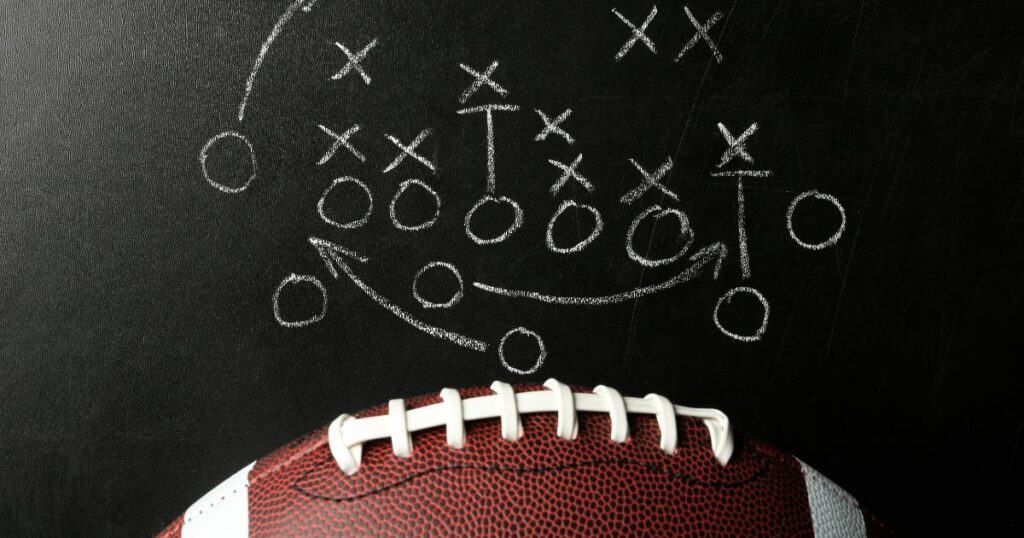
Understanding Zone Defense in Football
Zone defense is a popular defensive strategy in American football used to protect against the pass. In this defense, the players are assigned specific areas on the field, called zones, to defend.
The goal of zone defense is to make it difficult for the opposing quarterback to complete passes by forcing them to throw into tight coverage.
Types of Zone Coverage
There are different types of zone coverage, including Cover 2, Cover 3, and Cover 4.
Cover 2 divides the field into two deep zones, with two safeties responsible for defending each zone. The cornerbacks cover the short zones on the outside of the field.
Cover 3 divides the field into three deep zones, with three defenders responsible for each zone.
Cover 4, also known as “quarters,” divides the field into four deep zones, with four defenders responsible for each zone.
| Type of Zone Coverage | Description |
|---|---|
| Cover 2 | Two deep zones, two safeties responsible for each zone, cornerbacks cover the short zones |
| Cover 3 | Three deep zones, three defenders responsible for each zone |
| Cover 4 | Four deep zones, four defenders responsible for each zone |
Advantages and Disadvantages
Zone defense has several advantages and disadvantages.
One of the main advantages of zone defense is that it can confuse the opposing quarterback by making it difficult for them to read the coverage.
Additionally, zone defense can be effective against teams with strong passing attacks, as it allows defenders to focus on the pass rather than the run.
On the other hand, zone defense can be vulnerable to quick passes and can leave gaps in coverage if not executed properly.
Additionally, zone defense requires high communication and coordination among defenders, which can be challenging to achieve.
In conclusion, zone defense is a popular defensive strategy in American football that can be effective when executed properly.
By understanding the different types of zone coverage and the advantages and disadvantages of this defense, teams can make informed decisions about when to use zone defense and how to execute it best.
Key Elements of Zone Defense
Zone defense is a popular defensive strategy in American football where players on the defense are assigned specific areas on the field, called zones, to defend.
The key elements of zone defense include Cover 2, Cover 3, Cover 4, Cover 6, Cover 7, and Tampa 2.
Cover 2
Cover 2 is a zone defense scheme where the defense is divided into two deep safeties and five underneath defenders.
The two safeties cover the field’s deep halves, while the five underneath defenders cover the short and intermediate routes.
Cover 2 is effective against the short passing game but can be vulnerable to deep passes.

Cover 3
Cover 3 is a zone defense scheme where the defense is divided into three deep defenders and four underneath defenders.
The three deep defenders cover the field’s deep thirds, while the four underneath defenders cover the short and intermediate routes.
Cover 3 is effective against both the short and deep passing game.
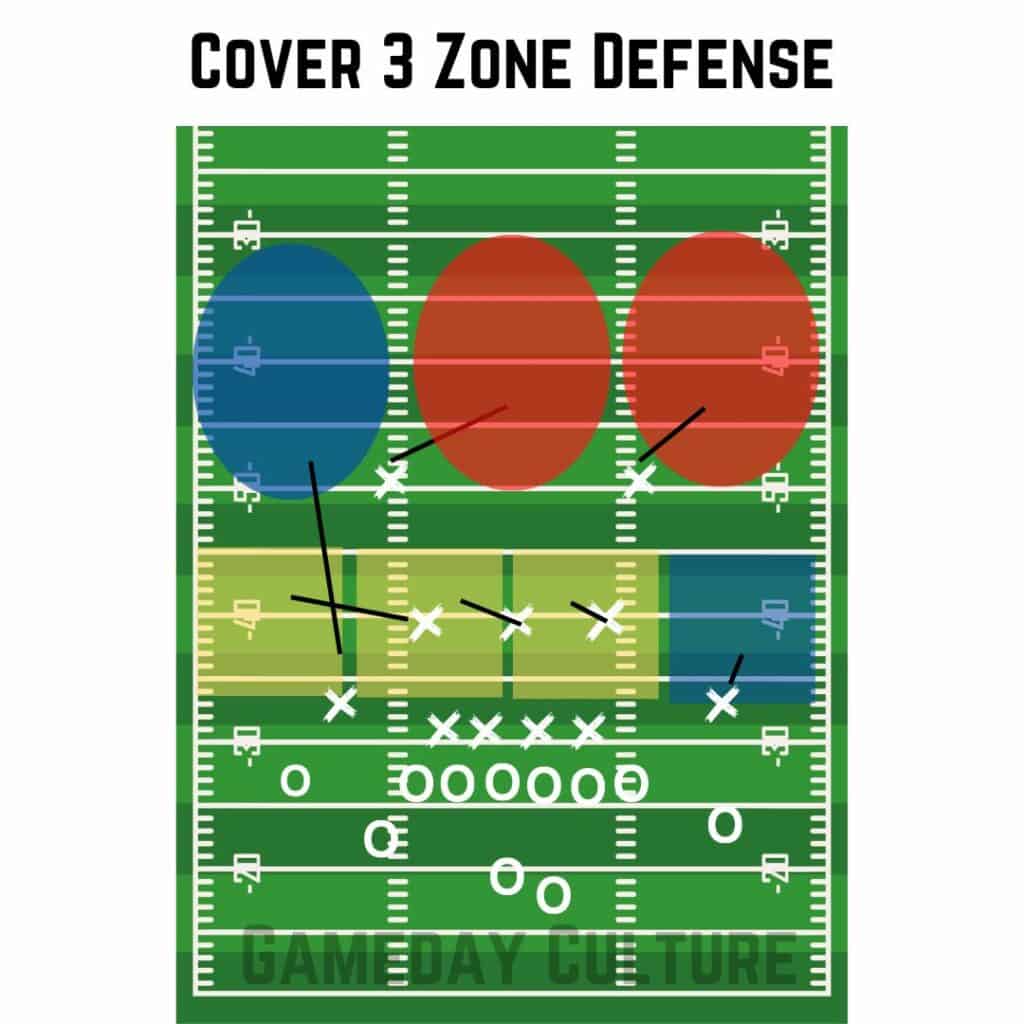
Cover 4
Cover 4 is a zone defense scheme where the defense is divided into four deep defenders, each guarding one-fourth of the deep zone.
Cover 4 is almost always used to defend against deep passes.
The most basic Cover 4 scheme involves 3 cornerbacks and 2 safeties.
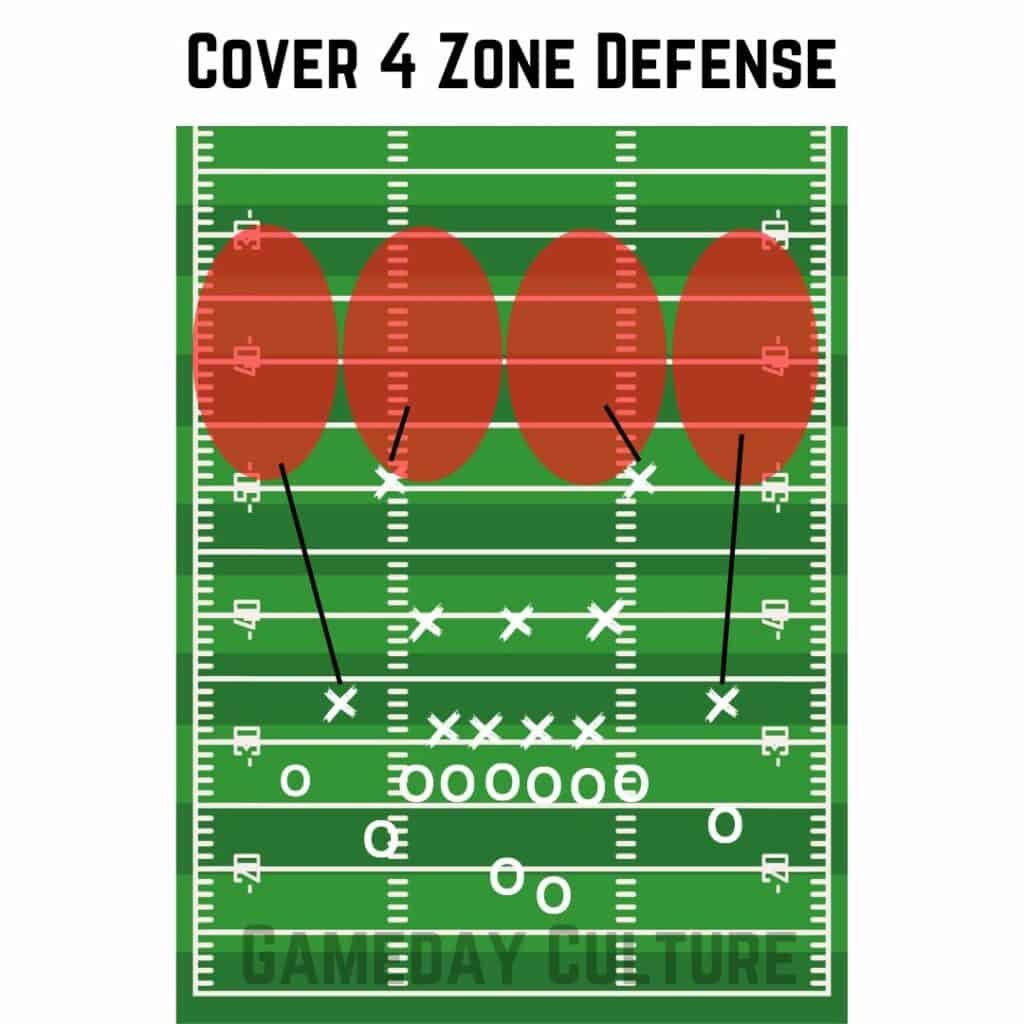
Cover 6
Cover 6 is a zone defense scheme that combines elements of Cover 2 and Cover 4. The defense is divided into two deep safeties and four underneath defenders.
One safety covers a deep half of the field, while the other safety and the four underneath defenders cover the short and intermediate routes.
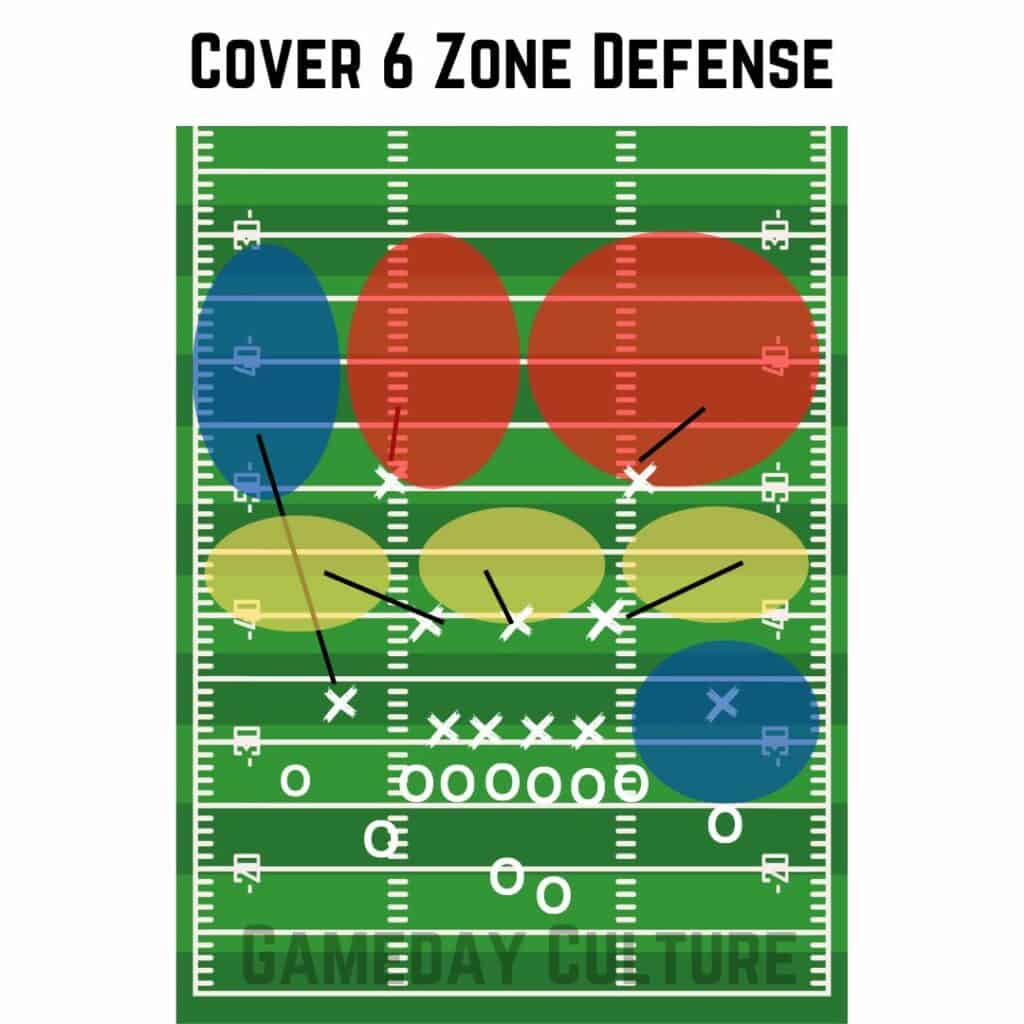
Cover 7
Cover 7 is a zone defense scheme that is also known as “quarters coverage”.
The defense is divided into four deep defenders and three underneath defenders.
The four deep defenders cover the deep quarters of the field, while the three underneath defenders cover the short and intermediate routes.
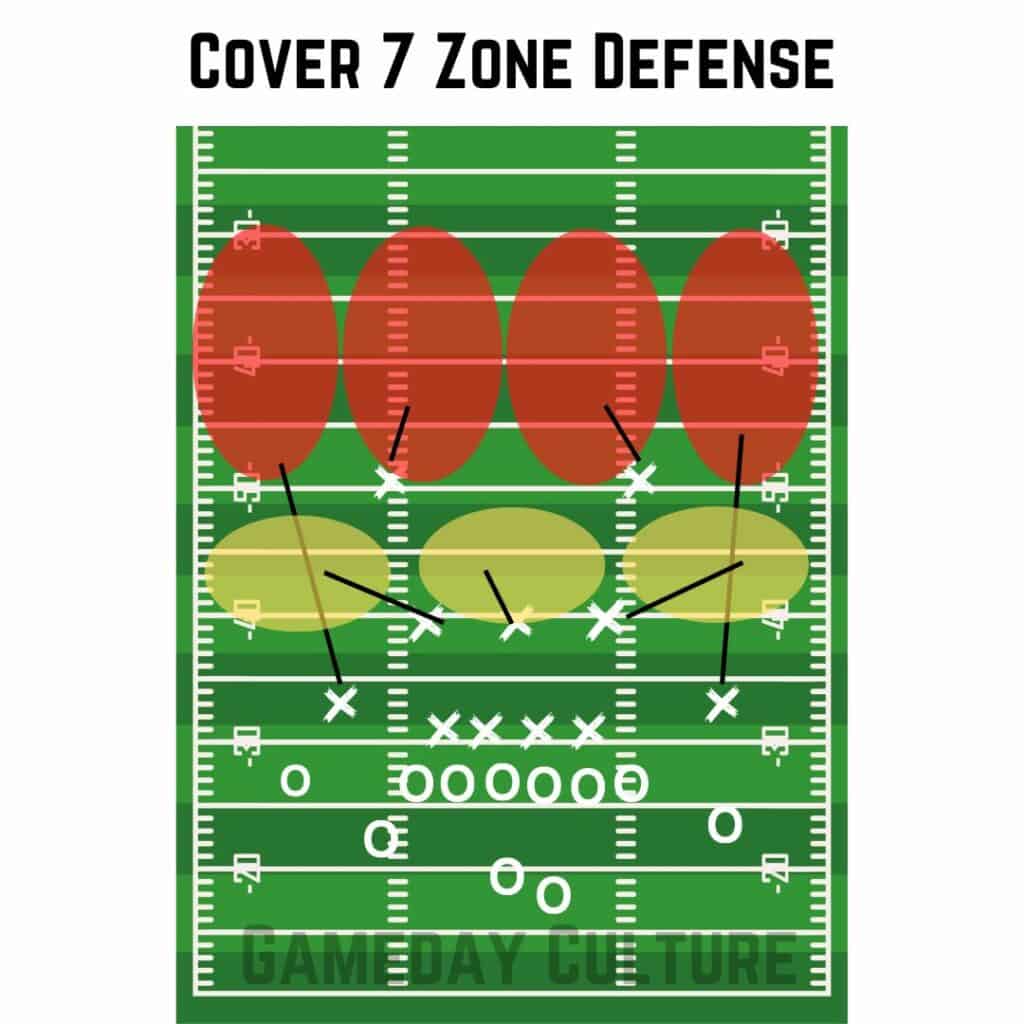
Tampa 2
Tampa 2 is a zone defense scheme that is a variation of Cover 2. In Tampa 2, the middle linebacker drops back into coverage to cover the middle of the field, allowing the two safeties to cover the deep halves of the field.
Tampa 2 is effective against both the short and deep passing game.
In zone defense, players are assigned specific areas on the field to defend, rather than being responsible for covering a specific player, as is the case in man-to-man defense.
The players on the defense are divided into defensive backs, linebackers, and defensive linemen.
The defensive backs are responsible for covering the deep zones, while the linebackers and defensive linemen are responsible for covering the short and intermediate zones.
Overall, zone defense is an effective defensive strategy that can be used to defend against both the short and deep passing game.
By assigning players specific areas to defend, the defense can effectively cover the entire field and limit the opposing team’s scoring opportunities.
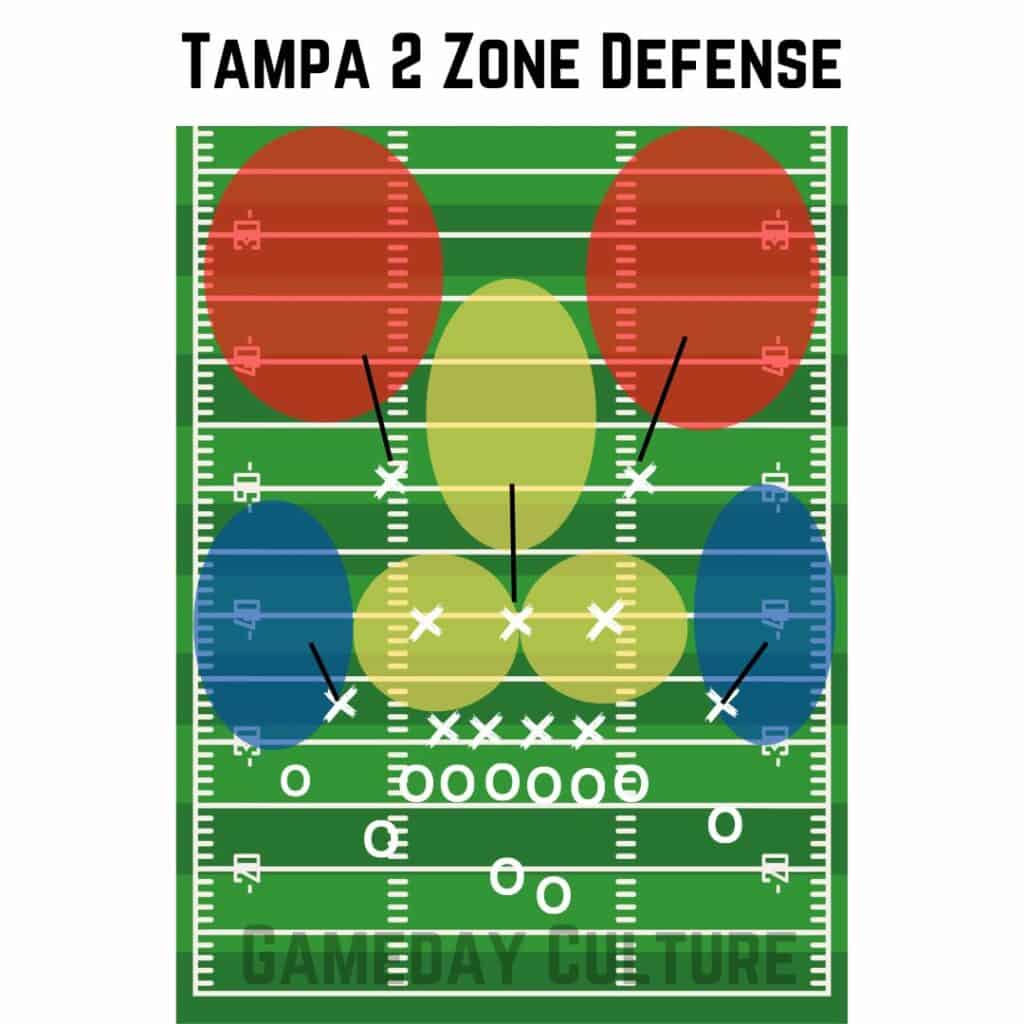
Zone Coverage Vs Man Coverage
Strength and Weakness of Each
When it comes to defending against the pass in football, there are two main types of coverage: zone coverage and man coverage. Each has its own strengths and weaknesses.
Zone Coverage
Zone coverage involves defenders covering a specific area or zone on the field. This type of coverage is often used to defend against short and intermediate passes. It can be effective in preventing big plays and forcing the offense to make short, quick passes.
Strengths:
- Effective against short and intermediate passes
- Can prevent big plays
- Forces the offense to make quick decisions
Weaknesses:
- Can leave gaps in the coverage
- May not be effective against deep passes
- Can be vulnerable to misdirection plays
Man Coverage
Man coverage, also known as man-to-man coverage or man-to-man defense, involves defenders matching up with specific offensive players. This type of coverage is often used to defend against deep passes and can be effective in taking away a team’s top receiving threat.
Strengths:
- Effective against deep passes
- Can take away a team’s top receiving threat
- Can disrupt timing routes
Weaknesses:
- Can leave other offensive players open
- Can be vulnerable to misdirection plays
- Requires skilled defenders to execute effectively
In summary, both zone coverage and man coverage have their strengths and weaknesses. Coaches will often use a combination of both types of coverage in order to keep the offense guessing and prevent big plays.
Role of Players in Zone Defense
Defensive Backs
Defensive backs play a crucial role in zone defense. They are responsible for covering specific areas of the field and preventing the opposing team’s wide receivers from catching passes. They need to be quick, agile, and have excellent reaction time to be effective in zone coverage.
In zone defense, defensive backs are assigned specific zones to cover. They are responsible for reading the quarterback’s eyes, anticipating the receiver’s movements, and quickly reacting to any changes in the play. They need to be able to switch between zones quickly and communicate effectively with their fellow defensive backs to ensure that there are no gaps in the coverage.
Linebackers
Linebackers are another critical component of zone defense. They are responsible for covering the middle of the field, which is often the most vulnerable area in zone coverage. They need to be able to read the quarterback’s eyes and react quickly to any changes in the play.
In zone defense, linebackers are typically assigned to cover specific zones in the middle of the field. They need to be able to drop back into coverage quickly and effectively, but also be able to come up and make tackles if the opposing team runs the ball.
Safeties
Safeties are the last line of defense in zone coverage. They are responsible for preventing any deep passes and ensuring that there are no big plays. They need to be able to read the quarterback’s eyes, anticipate the play, and quickly react to any changes in the play.
In zone defense, safeties are typically assigned to cover the deep zones. They need to be able to recognize when a receiver is running a deep route and quickly get into position to prevent any long passes.
| Position | Responsibilities |
|---|---|
| Defensive Backs | Cover specific zones, read the quarterback’s eyes, communicate with fellow defensive backs |
| Linebackers | Cover the middle of the field, drop back into coverage, come up and make tackles |
| Safeties | Prevent deep passes, cover deep zones, recognize deep routes |
Overall, zone defense is a complex defensive scheme that requires all players to work together effectively. Each player has a specific role to play, and they need to be able to communicate effectively and react quickly to any changes in the play. By working together, a team can effectively shut down the opposing team’s passing game and prevent any big plays.
Strategies and Techniques in Zone Defense
Passing Plays
In zone defense, the defensive players are assigned to specific areas on the field, called zones, to defend against passing plays. The defense will assign players to guard portions of the field, forming a defensive “shell” that the defense hopes will either prevent the offense from completing a pass or ensure a defensive player is able to tackle the receiver after a completed pass. The goal is to limit the number of open spaces for the offense to throw to.
Blitzing
Blitzing in zone defense is a risky move as it can leave open spaces on the field for the offense to exploit. However, it can also be an effective technique to disrupt the quarterback’s timing and force him to throw the ball earlier than he wants to. This can lead to interceptions or incompletions.
Interceptions
Interceptions are a key component of zone defense. Defensive players will look to jump routes and intercept passes. This is especially effective in the curl zone, where the quarterback is often looking to throw quick passes to his receivers.
Deep Passes
Deep passes are a weakness of zone defense as there are often open spaces in the deep part of the field. However, the defense can counter this by assigning safeties to cover the deep part of the field. This is known as Cover 2.
Crossing Routes
Crossing routes can be difficult to defend in zone defense as the defensive players are responsible for specific zones and may not be able to cover the entire route. However, the defense can counter this by assigning linebackers to cover the underneath coverage and the safeties to cover the deep coverage.
| Technique | Advantage | Disadvantage |
|---|---|---|
| Blitzing | Disrupts quarterback’s timing | Leaves open spaces on the field |
| Interceptions | Can lead to turnovers | Risky |
| Cover 2 | Effective against deep passes | Weakness in the flats |
| Assigning linebackers to underneath coverage | Effective against crossing routes | Leaves deep part of the field open |
| Assigning safeties to deep coverage | Effective against deep passes | Leaves flats open |
Overall, zone defense is a popular defensive coverage strategy in football. It allows the defense to cover more of the field and limit the number of open spaces for the offense to throw to. However, it does have its weaknesses and can be exploited by a skilled quarterback and offense.
Role of Defensive Coordinators
Defensive coordinators play a crucial role in designing and implementing defensive strategies in football. They are responsible for managing the roster of defensive players, overseeing assistant coaches, developing the defensive game plan, and calling plays for the defense during the game.
Defensive Fronts
One of the primary responsibilities of defensive coordinators is to design effective defensive fronts. Defensive fronts refer to the alignment of the defensive players at the line of scrimmage. The goal of the defensive front is to stop the offense from advancing the ball.
Defensive coordinators must consider various factors when designing defensive fronts, including the strengths and weaknesses of their own team, the offensive formation of the opposing team, and the game situation. They can use various defensive fronts, such as the 4-3, 3-4, or 5-2, depending on the situation.
Big Plays
Another important responsibility of defensive coordinators is to prevent big plays by the opposing team. Big plays refer to long runs or passes that result in significant yardage gains or touchdowns.
Defensive coordinators can prevent big plays by using zone defense, man-to-man coverage, or a combination of both. They can also use blitzes to put pressure on the opposing quarterback and disrupt their passing game.
To prevent big plays, defensive coordinators must analyze the strengths and weaknesses of the opposing team’s offense and come up with a game plan that neutralizes their strengths and exploits their weaknesses.
| Role of Defensive Coordinators | |
|---|---|
| Responsibilities | Designing plays for the defense, making decisions on positions and roles, game preparation, opponent scouting, teaching, training, and execution |
| Defensive Fronts | The alignment of the defensive players at the line of scrimmage |
| Big Plays | Long runs or passes resulting in significant yardage gains or touchdowns |
Defensive coordinators are an integral part of a football team’s success. They must have a deep understanding of the game, excellent communication skills, and the ability to adapt to changing game situations. By designing effective defensive fronts and preventing big plays, they can help their teams win games and achieve their goals.
Zone Defense in Other Sports
Similarities
Zone defense is not exclusive to football. Many other team sports use this defense strategy, such as basketball, lacrosse, and ultimate. In these sports, the defensive team assigns each player a specific area of the field or court to cover, rather than having each player mark a specific opponent. This allows the defense to cover more ground and potentially disrupt the opposing team’s offensive strategy.
In basketball, zone defense is often used to protect the paint and limit the opposing team’s scoring opportunities close to the basket. The most common zone defense is the 2-3 zone, where two defenders cover the top of the key and three defenders guard the paint.
In lacrosse, zone defense is used to protect the goal and limit the opposing team’s scoring opportunities. The most common zone defense is the 3-3 zone, where three defenders cover the top of the field and three defenders guard the goal.
In ultimate, zone defense is used to force the opposing team to pass the disc around the field rather than make forward progress. The most common zone defense is the 3-3-1 zone, where three defenders cover the front of the field, three defenders cover the back of the field, and one defender guards the middle.
Differences
While the basic concept of zone defense is similar across sports, there are some key differences in how it is executed.
In basketball, the defense is not allowed to stay in a zone for more than three seconds without actively guarding an offensive player. This is known as the three-second rule and prevents the defense from simply clogging up the paint and preventing the offense from scoring.
In lacrosse, the defense is not allowed to use their body to impede the movement of an offensive player. This is known as a body check and is only allowed when the offensive player has possession of the ball.
In ultimate, the defense is not allowed to touch the offensive player with the disc. This is known as a marking violation and results in a turnover.
| Sport | Most Common Zone Defense | Key Difference |
|---|---|---|
| Basketball | 2-3 zone | Three-second rule |
| Lacrosse | 3-3 zone | No body checking |
| Ultimate | 3-3-1 zone | No touching the offensive player with the disc |
The NCAA has different rules and regulations for each sport, so it’s important to understand the specific rules for each sport at the college level.
Frequently Asked Questions
When should a football team use zone defense?
A football team should use zone defense when they want to protect against the pass. Zone defense is a defensive coverage strategy where players on the defense are assigned specific areas on the field, called zones, to defend. Whenever an offensive player enters the zone, the defensive player is there to stop them on both running plays and passing plays.
How does zone defense differ from man-to-man defense in football?
In man-to-man defense, each defender is assigned to cover a specific offensive player. In zone defense, defenders are assigned specific areas on the field to cover. Zone defense is typically used to protect against the pass, while man-to-man defense is used to protect against both the pass and the run.
What are the advantages of using a zone defense in football?
The advantages of using a zone defense in football include:
- Better protection against the pass
- Allows defenders to play to their strengths
- Can confuse the offense by changing the coverage
What are the weaknesses of a zone defense in football?
The weaknesses of a zone defense in football include:
- Can leave gaps in coverage
- Can be vulnerable to misdirection plays
- Can be less effective against strong passing offenses
What are the best zone defense strategies for football?
Some of the best zone defense strategies for football include:
- Cover 2: In Cover 2, the defense is split into two deep safeties and five underneath defenders. This is a popular zone defense because it provides good protection against deep passes.
- Cover 3: In Cover 3, the defense is split into three deep defenders and four underneath defenders. This is a popular zone defense because it provides good protection against both short and deep passes.
- Cover 4: In Cover 4, the defense is split into four deep defenders and three underneath defenders. This is a popular zone defense because it provides good protection against deep passes.
What is the difference between Cover 2 and Cover 3 defenses in football?
The main difference between Cover 2 and Cover 3 defenses in football is the number of deep defenders. In Cover 2, there are two deep defenders, while in Cover 3, there are three deep defenders. This means that Cover 3 provides better protection against deep passes, while Cover 2 provides better protection against short and intermediate passes.
